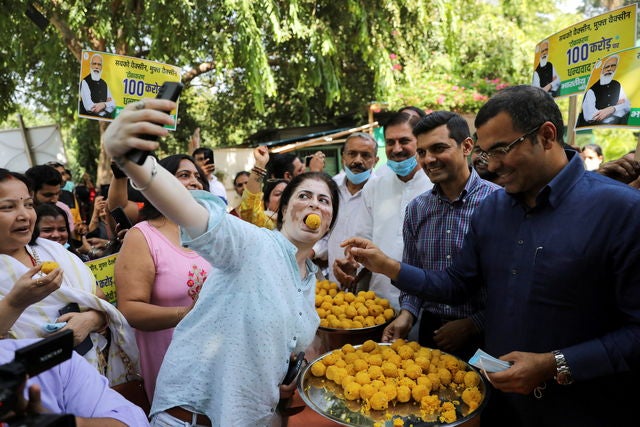One billion doses and counting: India’s bright spots in COVID-19 management
Health leaders reflect on some of the country's successes managing the second wave of COVID-19

How do you vaccinate one billion people? With empathy, ingenuity, and sheer persistence.
That was how Govindraj Ethiraj, founder of IndiaSpend, framed the discussion in a webinar entitled Bright Spots in COVID-19 Management in India: Successful Vaccination Stories. The conversation, hosted in late October by IndiaSpend and Exemplars in Global Health, was part of an initiative by IndiaCOVIDSOS to research and share bright spots in the care and management of COVID-19 during India’s second wave of the disease.
According to the panelists, empathy meant meeting communities on their terms, using their languages, following their customs, and addressing their fears. Ingenuity meant being tireless and innovating until the last mile was reached. And sheer persistence meant simply not giving up.
“We need to reflect on what’s happened at the ground level. It’s a multi-factorial problem,” said WHO Chief Scientist Dr. Soumya Swaminathan, the event’s co-chair, about crises that require multi-sectoral interventions. “The health system alone, in the future, is not going to be able to address our health problems because of the determinants of health.” Taking a holistic view was essential, she said, adding that health was not an issue that could be addressed by health departments alone. Communities, districts, and state governments must all take part.
Unsurprisingly, community involvement was one of the biggest drivers of recent successful COVID-19 vaccination campaigns in India. Speakers from some of the country’s most remote locations shed light on how they reached people everywhere.
Dr. Mittali Sethi, IAS, Chief Executive Officer, Zilla Parishad, Chandrapur, shared insights from her previous posting as Project Officer, Integrated Tribal Development Project (ITDP) in Dharni (Melghat, Amravati), the first village in Maharashtra to achieve complete vaccination for those over 45. The work started, she said, by enlisting local healers and doctors to encourage vaccination in Korku, a local language only spoken by 600,000 people worldwide. Pro-vaccination messages were also recorded and played on village loudspeakers and local leaders were encouraged to use catchy slogans about vaccinations. Teams on the ground, she added, were able to directly respond to the "irrational" concerns of the villagers, which needed to be addressed.
Next, the campaign focused on creating community incentives, including holding vaccinations in public, encouraging people to applaud the vaccinated, serving food, and turning vaccination drives into social occasions. “Melghat was now no longer a land of problems, it was a land of possibilities,” she said.
Somesh Mishra, IAS, District Magistrate, shared lessons from the tribal district of Jhabua, Madhya Pradesh, which he said was “marred with the stigma of lower literacy and superstition,” as well as misinformation and fake news. Because of this, he said, Jhabua had just a 10 percent vaccination rate as late as June, and was bottom ranked among all the districts in the state.
To counter this, officials started using traditional local gatherings called khatla baithak, during which village elders would sit with people and resolve their disputes (khatla baithak combines khat or wooden bed, and baithak, or meeting). They used these traditional meetings to build trust and counter both misinformation and vaccine hesitancy. Crisis management committees were also formed in villages to enlist young adults to take the vaccine in the hope that would motivate their parents to get the shots as well. Short films about the vaccine were also distributed at drive-through vaccination centers, now set up for two-wheelers, cycles, and tricycles to boost demand.
These innovative strategies worked. After khatla baithaks started, Jhabua reported about 5,000 vaccinations a day – and even hit a local record of 35,000 vaccinations on one day – compared to the previous average of 1,800 and 2,100 daily vaccinations. Today, it has reached over 94 percent first dose vaccination coverage, becoming one of the most vaccinated districts in the state.
Shirsat Kapil Ashok, IAS, District Magistrate East Champaran, also shared how officials achieved 95 percent COVID vaccination of adults in the Bankatwa block of the East Champaran district of Bihar in just two days, using what's been dubbed the "Bankatwa Way."
The Bankatwa block, according to the WHO, had low routine immunization coverage of just 64.3 percent "due to challenges of difficult terrain, poor health infrastructure and vaccine hesitancy in the community, among others." Despite that, officials adopted a mission mode approach and along with the WHO, civil society organizations, local elected leaders and religious leaders, coordinated a massive mobilization that in 48 hours, vaccinated 55,000 of the block's 62,000 registered inhabitants across 102 villages.
The effort has had a knock-on effect across the district, Ashok said, with all nine urban local bodies and other blocks in the district now having been vaccinated in similar campaigns, delivering 100 percent first dose coverage by early October.
Dr. CK Mishra, Ret. IAS, Former Secretary for India’s Ministry of Health and Family Welfare, who also co-chaired the webinar, added that in the same way that traditional stories have been passed down from generation to generation, the sharing of success stories was essential. “Every new crisis you have does not need new solutions – use your existing systems well, you can find solutions,” he added.
